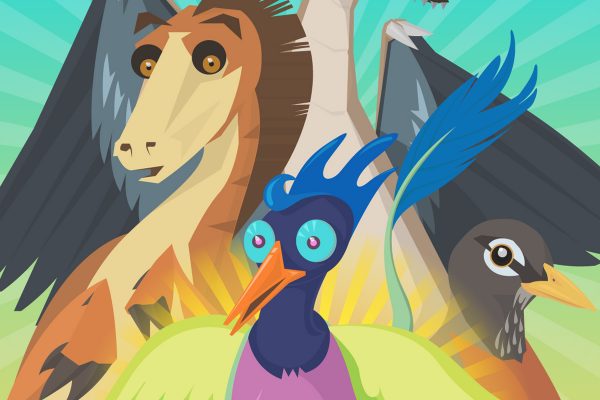Flap to the Future: The Flight Adaptations Game
Explore the evolution of flight with Bird Academy’s Flap to the Future.
Play Flap to the Future
Preview the game:
Master the skies one adaptation at a time
Tawa: Feel the power of ground speed
Players start the game as Tawa, a small dinosaur that lived 200 million years ago in the floodplains of what is now the American Southwest. There is little debate among scientists that birds evolved from dinosaurs from the theropod group, like Tawa. One of the big clues connecting birds to this group of dinosaurs comes from the many impressions of simple feathers found on fossils discovered over the past few decades in China. Based on this evidence, scientists now believe that so called “dino fuzz” feathers covered the bodies of most theropods. These feathers probably helped them stay warm. The feathers also had patterns and colors, so perhaps also helped dinosaurs either stay camouflaged or show off. In the Late Triassic, although bird ancestors had feathers, they were still earthbound.
Microraptor: Feel the thrill of catching air
Players first catch some air as Microraptor. With specialized flight feathers on all four limbs, this extinct dinosaur from 120 million years ago appears to have been a gliding specialist and a tree climber. Though the flight feathers gave this creature lift and helped the animal stay aloft, Microraptor did not have the flight muscles to sustain flapping flight for long distances. Some scientists have suggested that it may have been able to take off from the ground and flap for short distances. Microraptor is not a bird or even a direct ancestor of modern birds, but rather an extinct offshoot of the larger group of theropod dinosaurs. Until paleontologists discover fossils of the very earliest birds, we can look to Microraptor to help us understand at least one of the evolutionary paths to flight. By the time of Microraptor, flight feathers had emerged as one of the key adaptations that helped some dinosaurs, and the earliest birds, become airborne.
American Robin: Feel the freedom of flapping flight
Players first feel the freedom of flapping flight as the American Robin, a modern passerine bird, or songbird. Flapping flight is one of the hallmarks of modern birds—the only living descendants of dinosaurs—and analyses of the bird family tree suggest that even flightless species like penguins descended from a flying ancestor. The ability to fly even short distances relies on the thrust generated from flapping and the lift developed from long, stiff flight feathers. Large, well-developed breast muscles power the wing flaps, and in robins these flight muscles make up about 10% of their total body weight. Thanks to the evolution of flapping flight, robins and many modern birds have the ability to migrate thousands of miles to take advantage of food and breeding resources in far flung places throughout the year.
Future Bird: The only constant is change
In the final level of Flap to the Future players explore life as a bird from the deep future. It is hard to envision what birds will be like 100 million years from now. But because evolution builds on the features that each generation inherits from its genetic relatives, we can predict that if flapping flight continues to benefit birds, it will stick around—and if not, it won’t. In this level of the game, players control the strength of each of the adaptations introduced in the previous levels. This encourages players to investigate the benefits and costs of each adaptation—a process that mirrors what happens over evolutionary time.
We invite educators to teach adaptation and evolution with Flap to the Future. Download classroom activities to accompany the game from The Cornell Lab’s K-12 Education program.
